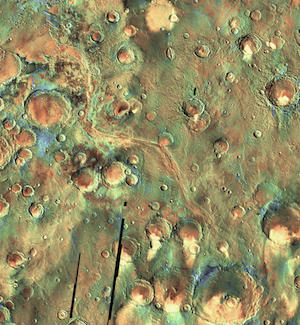THEMIS Support for MSL Landing Site Selection

Mawrth Valles MSL site
False colors derived from THEMIS data tell scientists about the nature of the ground in the area of Mawrth Valles. Warmer colors indicate harder and rockier terrain, while cool colors show surfaces coated with sand and dust. Because this ancient area contains clay sediments that may record traces of life, it is one of several potential landing sites for NASA's next Mars rover, the Mars Science Laboratory (MSL).
NASA/JPL-Caltech/Arizona State University
Download OriginalResearchers at the Mars Space Flight Facility at Arizona State University used data from the Thermal Emission Imaging System (THEMIS) to help scientists choose a landing site for the Mars Science Laboratory (MSL). This is NASA’s next-generation rover spacecraft, due for arrival in August 2011.
MSL’s mission is to collect Martian soil and rock samples and analyze them for organic compounds, looking for environmental conditions that could have supported microbial life now or in the past.
Following a workshop in summer 2006, scientists identified 36 candidate landing sites for further study. After additional workshops, the list was narrowed to four. Scientists and engineers are now using THEMIS and other spacecraft resources to assess these more closely from the standpoint of flight safety and scientific value.
The "Final Four": Landing Sites